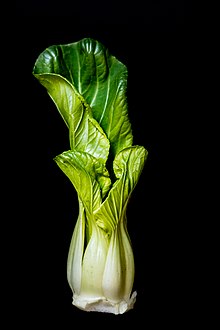| Bok choy | |
|---|---|
 Brassica rapa chinensis, called "bok choy" in the United States | |
| Species | Brassica rapa |
| Cultivar group | Chinensis |
| Origin | China, 5th century AD[1] |
Bok choy (American English, Canadian English, and Australian English), pak choi (British English, South African English, and Caribbean English) or pok choi (Brassica rapa subsp. chinensis) is a type of Chinese cabbage, used as food. Chinensis varieties do not form heads and have green leaf blades with lighter bulbous bottoms instead, forming a cluster reminiscent of mustard greens. It has a flavor between spinach and water chestnuts but is slightly sweeter, with a mildly peppery undertone. The green leaves have a stronger flavor than the white bulb.[2][3]
Chinensis varieties are popular in southern China, East Asia, and Southeast Asia. Being winter-hardy, they are increasingly grown in Northern Europe.[citation needed] Now considered a subspecies of Brassica rapa, this group was originally classified as its own species under the name Brassica chinensis by Carl Linnaeus.[citation needed] They are a member of the family of Brassicaceae or Cruciferae, also commonly known as the mustards, the crucifers, or the cabbage family.
- ^ Sanderson, Helen; Renfrew, Jane M. (2005). Prance, Ghillean; Nesbitt, Mark (eds.). The Cultural History of Plants. Routledge. p. 115. ISBN 0415927463.
- ^ "What Does Pak Choi Taste Like?". Thrive Cuisine. 2 March 2019. Retrieved 13 December 2021.
- ^ "Genetic Characterization of Brassica rapa chinensis L.,B. rapa parachinensis (L. H. Bailey) Hanelt, and B. oleracea alboglabra (L. H. Bailey) Hanelt Using Simple Sequence Repeat Markers" (PDF). Philippine Journal of Science. December 2009. Retrieved 16 February 2023.